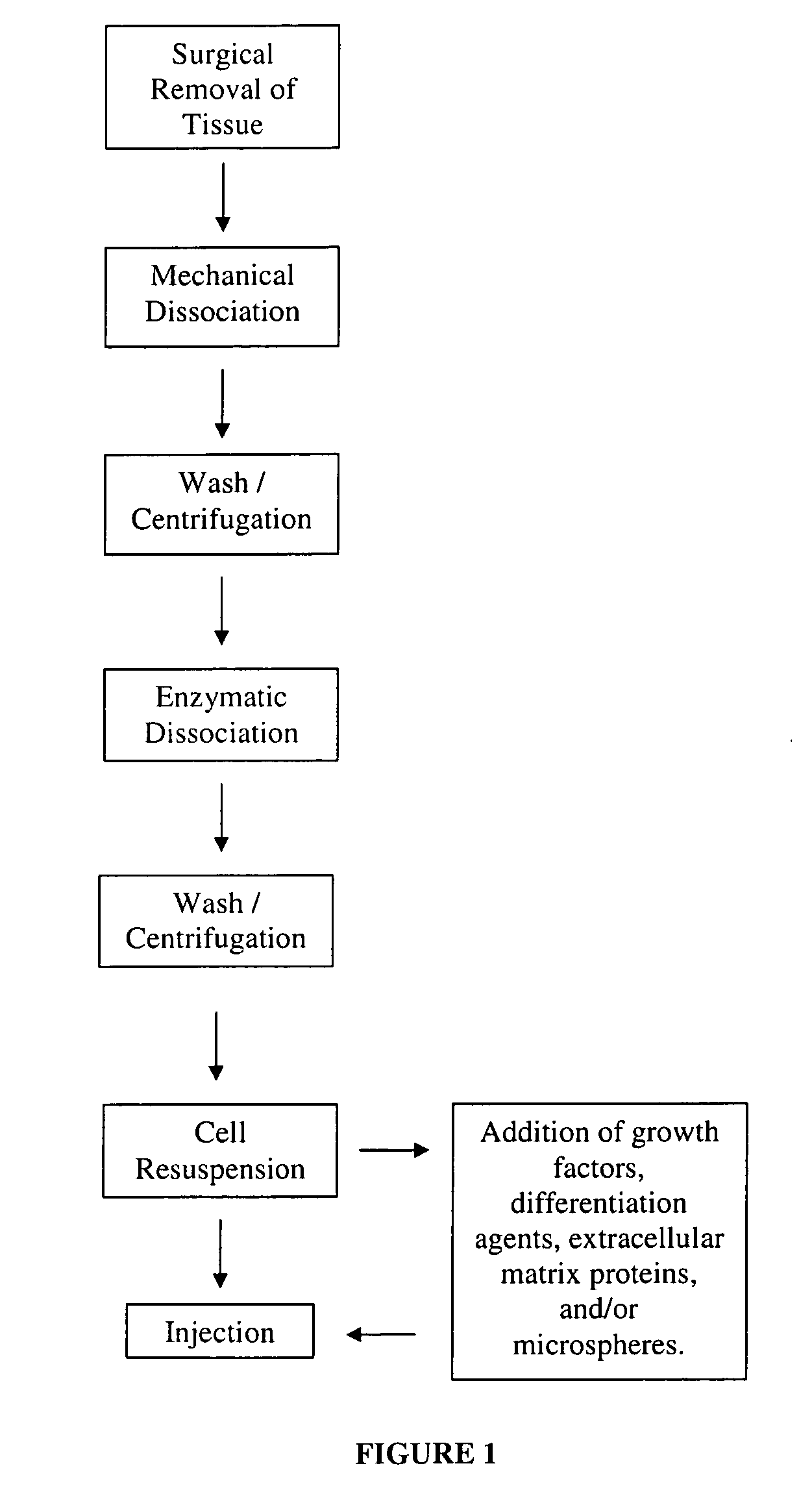Nonexpansion Protocol for Autologous Cell-Based Therapies
a technology of autologous cells and non-expansion protocol, which is applied in the direction of prosthesis, peptides, powder delivery, etc., can solve the problem of adding weeks to the procedure, and achieve the effect of reducing the risk of contamination and sufficient cell numbers
- Summary
- Abstract
- Description
- Claims
- Application Information
AI Technical Summary
Benefits of technology
Problems solved by technology
Method used
Image
Examples
example 1
Nonexpansion Protocol for Isolation of Autologous Cells for Cell-Based Therapy
[0029]In this example embodiment, cells are harvested from skeletal muscle biopsies or otherwise surgically derived tissue by mechanical and enzymatic means. See FIG. 1 as one example of a flowchart that helps to describe the method of this and other embodiments of the present invention. The tissue is first finely chopped on ice (or other cold and sterile surface) using a sterile scalpel and then washed three times in a sterile balanced salt solution optionally containing antibiotics and / or antimycotics. The cells are enzymatically dissociated (or via another dissociating means or process) by incubating with cell dissociation enzymes (e.g. any of trypsin, collagenase, or dispase and combinations thereof) for about one hour (or until the cells are sufficiently dissociated) at about 37° C. This embodiment is not necessarily limited to this time and temperature. After the enzymatic dissociation, the cells are...
example 2
Determination of In Vivo Retention Time, Survival, and Localization
[0030]In this example embodiment, a method is described for determining retention time, survival and localization of cells injected (or re-introduced) into the bladder.
[0031]Cell Preparation and Transplantation
[0032]Cells are isolated from muscle taken from the hind limb of newborn normal mice (or similar mammal) using mechanical and enzymatic means and then plated on 60 mm gelatin-coated plates in DMEM containing 10% fetal bovine serum, 10% horse serum, 1% glutamine (292 μg / ml), penicillin (100 U / ml) and streptomycin (100 μg / ml) (all from Invitrogen). The cells are incubated at about 37° C. for about 2 hours and then fluorescent latex microspheres (FLMs) are added at a dilution of 1:3000 to the cultures. After about 12 hour incubation at about 37° C., the cells are rinsed about three times with HBSS, detached with 0.25% trypsin-EDTA, and resuspended in HBSS at a concentration of 106 cells / ml. Ten microliters of the ...
example 3
Treatment of Stress Urinary Incontinence in Rats Using Cell-Based Therapy
[0035]This Example embodiment describes a treatment of stress urinary incontinence (SUI) in a rat model by injecting a mixture of nonexpanded, heterologous cells. This particular protocol may be useful in treating women having hysterectomies that also have stress urinary incontinence or in men exhibiting stress incontinence after a prostatectomy.
[0036]Animals
[0037]Female Sprague-Dawley rats, age 3-6 months, are used as a source of cells and as treatment animals. The animals are handled in compliance with the requirements of the Institutional Animal Care and Use Committee (IACUC) at our animal facility.
[0038]Description of Animal Model
[0039]The procedure is performed on female rats with electrocauterization-induced intrinsic sphincter deficiency (1) [Chemansky et al. “A model of intrinsic sphincteric deficiency in the rat: electrocauterization.”Neurolurol Urodyn. 2004; 23(2): 166-71]. This model decreases leak p...
PUM
| Property | Measurement | Unit |
|---|---|---|
| Time | aaaaa | aaaaa |
Abstract
Description
Claims
Application Information
 Login to View More
Login to View More - R&D
- Intellectual Property
- Life Sciences
- Materials
- Tech Scout
- Unparalleled Data Quality
- Higher Quality Content
- 60% Fewer Hallucinations
Browse by: Latest US Patents, China's latest patents, Technical Efficacy Thesaurus, Application Domain, Technology Topic, Popular Technical Reports.
© 2025 PatSnap. All rights reserved.Legal|Privacy policy|Modern Slavery Act Transparency Statement|Sitemap|About US| Contact US: help@patsnap.com


